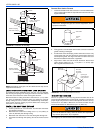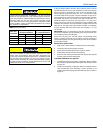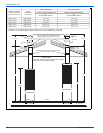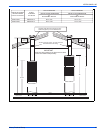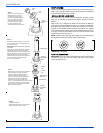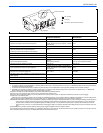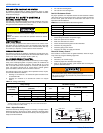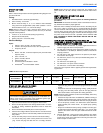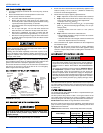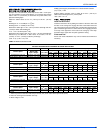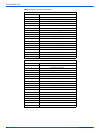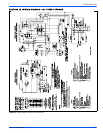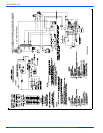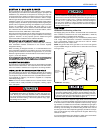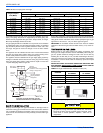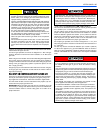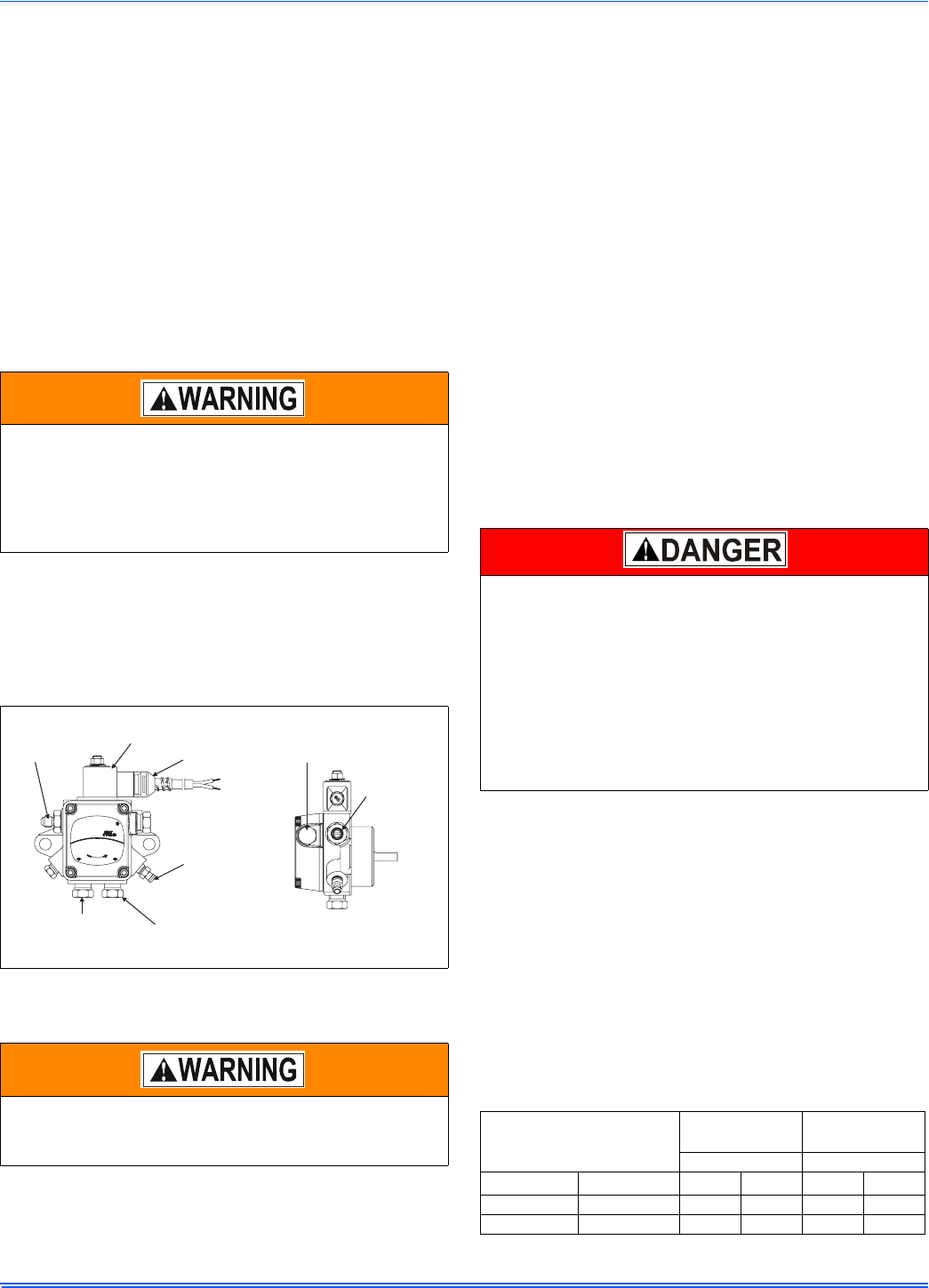
107272-UIM-B-1105
24 Unitary Products Group
IGNITION SYSTEM SEQUENCE
1. Turn the oil supply ON at external valve on the oil pump, and/or at
the oil tank.
2. Set the thermostat above room temperature to call for heat.
3. System start-up will occur as follows:
a. The burner motor will start and come up to speed.
b. Shortly after the burner motor starts-up, the ignition trans-
former will provide 10,000 volts through the electrods causing
a spark that will last approximately 15 seconds.
c. The solenoid valve on the oil pump will open providing oil flow
to the nozzle.
d. The oil vapor will ignite. The cad cell flame detector will
detect the flame. The resistance will drop below 1600 ohms.
e. After flame is established, the supply air blower will start
when the fan switch reaches approximately 110° F (43.3° C).
f. After flame is extinguished, the supply air blower will continue
to operate until the air temperature at the fan switch is below
90
o
F (32.2
o
C).
IMPORTANT: Burner ignition may not be satisfactory on first start-up
due to residual air in the oil line or until pump pressure is adjusted. The
ignition control will make 3 attempts to light before locking out.
The furnace should have a safety or fire shut-off valve connected to the
inlet part of the oil pump to shut off the flow of oil in an emergency.
Refer to Figure 36 for inlet port location.
ADJUSTMENT OF OIL PUMP PRESSURE
SET COMBUSTION WITH INSTRUMENTS
1. Let the burner run for approximately 5 to 10 minutes.
2. Set the over-fire or stack draft to level specified by appliance man-
ufacturer (usually -0.01” to -0.02” w.c. (-000024 to -0.0050 kPa)
over-fire for natural draft applications).
3. Follow these four steps to properly adjust the burner:
a. Step 1: Adjust the air until a trace of smoke level is achieved.
b. Step 2: At the trace of smoke level, measure the CO
2
(or O
2
).
This is the vital reference point for further adjustments.
• Example: 13.5% CO
2
(2.6% O
2
).
c. Step 3: Increase the air to reduce CO
2
by 1 to 2 percentage
points. (O
2
will be increased by approximately 1.4 to 2.7 per-
centage points).
• Example: Reduce CO
2
from 13.5% to 11.5%. (2.6% to
5.3% O
2
).
d. Step 4: Recheck smoke level. It should be zero.
• This procedure provides a margin of reserve air to accom-
modate variable conditions.
• If the draft level has to be changed, recheck the smoke and
CO
2
levels. Adjust the burner air if necessary.
4. Once combustion is set, tighten all fasteners on the air adjustment
and escutcheon plate.
5. Start and stop the burner several times to ensure satisfactory
operation. Test the primary control and all other appliance safety
controls to verify that they function according to the manufacturer’s
specifications.
ADJUSTMENT OF TEMPERATURE RISE
After about 20 minutes of operation, determine the furnace temperature
rise. Take readings of both the return air and the heated air in the ducts,
about six feet (1.83 m) from the furnace where they will not be affected
by radiant heat.
FILTER PERFORMANCE
The airflow capacity data published in Table 14 represents blower per-
formance WITH CLEAN filters.
The filter pressure drop values in Table 13 are typical values for the
type of filter listed and should only be used as a guideline. Actual pres-
sure drop ratings for each filter type vary between filter manufacturers.
DO NOT USE Pleated Media or Hogs Hair filters on this furnace.
Be sure to check for leaks in the oil line and fittings. A leak will cause oil
pump to loose it’s prime. Repair leaks before continuing with the final
adjustments to the oil burner.
FIRE OR EXPLOSION HAZARD
Failure to follow the safety warnings exactly could result in serious
injury, death or property damage.
Pressing the reset button repeatedly could cause a pool of oil to
form in the bottom of the chamber. If ignited, could result in a very
dangerous situation which could result in personal injury, property
damage, and/or death.
FIGURE 36: Oil Pump
The combustion must be adjusted using test instruments. Fail-
ure to do so could result in burner or appliance failure, caus-
ing potential severe personal injury, death, or substantial
property damage.
4GPH100-150PSI3450RPM
3GPH150-200PSI3450RPM
NO. 2 &LIGHTER FUEL
INLET
BY-PASS
Exclusivelyfor Beckett
Made by Suntec
INLET
NO. 2FUEL
A2EA-6520
Beckett
CLEANCUT
USEONLYWITH
VALVEONDELAY
Pressure
Adjustment
Screw
Inlet Port
1/4 NPTF
Bleed &
Gauge Port
Return Port
Install 1/16” by Pass Pipe
Plug For Two-Pipe System Only
(Use 5/32” Allen Wrench)
Cordset
By Pass
Solenoid
Valve
Inlet Port
1/4 NPTF
(0.64 cm)
Nozzle Port
3/16 Flare
Fittting
The temperature rise, or temperature difference between the return
air and the supply (heated) air from the furnace, must be within the
range shown on the furnace rating plate and within the application
limitations shown in Table 8 “ELECTRICAL AND PERFORMANCE
DATA”.
The supply air temperature cannot exceed the “Maximum Supply
Air Temperature” specified in these instructions and on the fur-
nace rating plate. Under NO circumstances can the furnace be
allowed to operate above the Maximum Supply Air Temperature.
Operating the furnace above the Maximum Supply Air Temperature
will cause premature heat exchanger failure, high levels of Carbon
Monoxide, a fire hazard, personal injury, property damage, and/or
death.
TABLE 13:
Filter Performance - Pressure Drop Inches W.C. and (kPa)
Airflow Range
Minimum
Opening Size
Filter Type
Disposable
1 Opening 1 Opening
CFM Cm/m
In
2
m
2
inwc kPa
1001 - 1250 28.35 - 35.40 488 45.34 0.1 0.0249
1251 - 1500 35.42 - 42.47 488 45.34 0.1 0.0249



